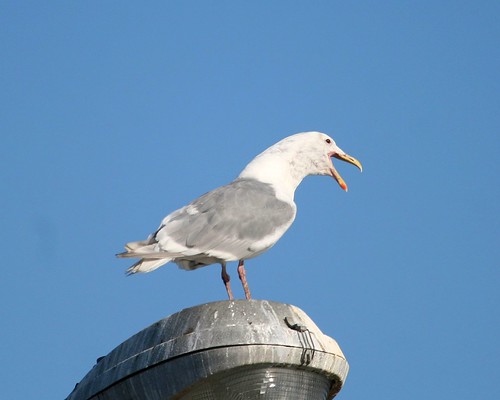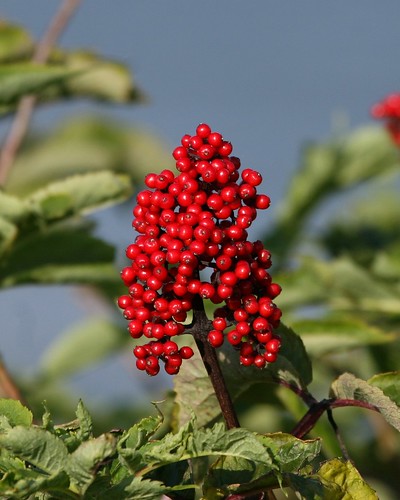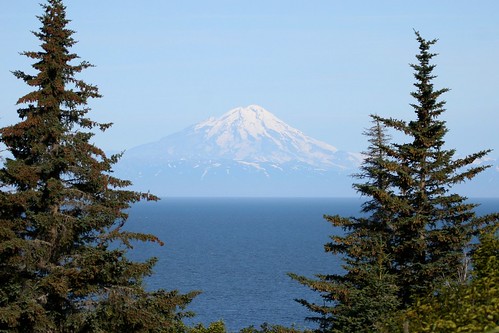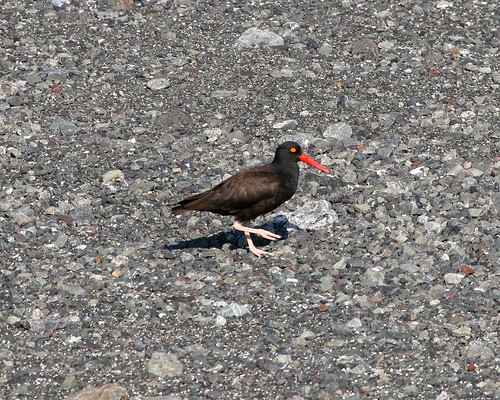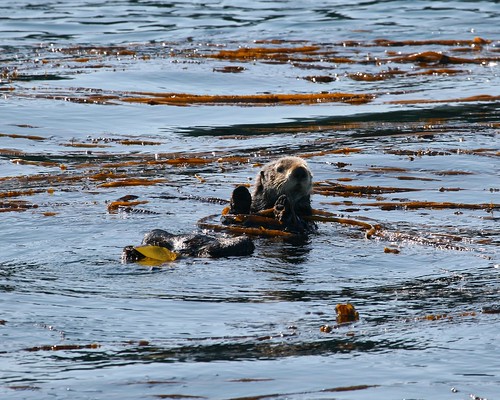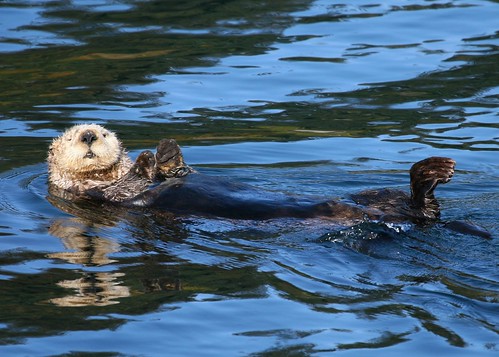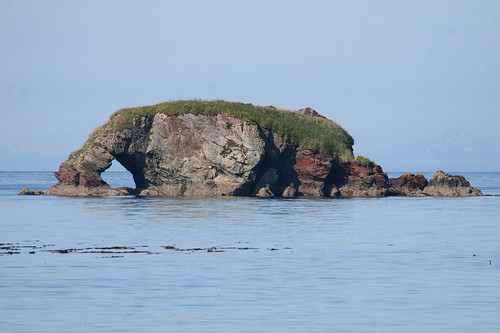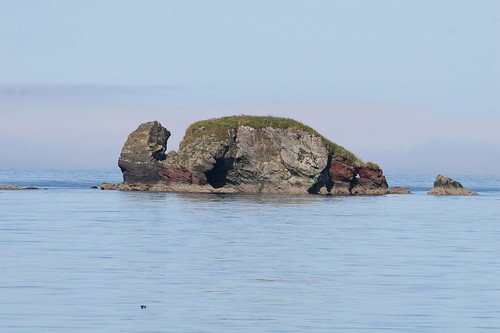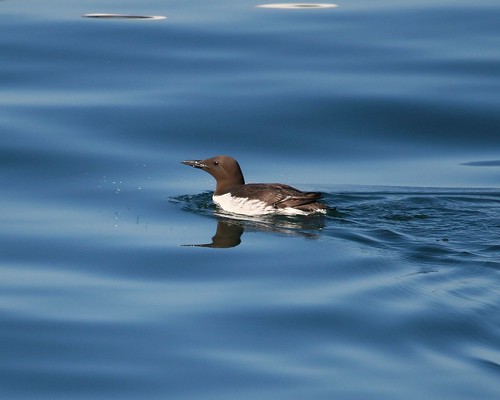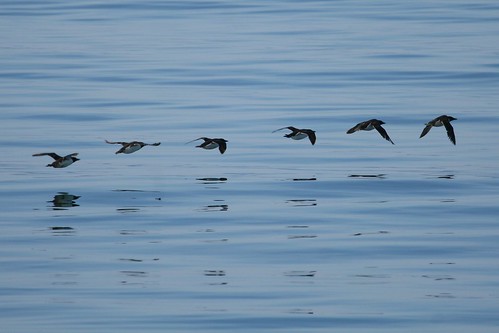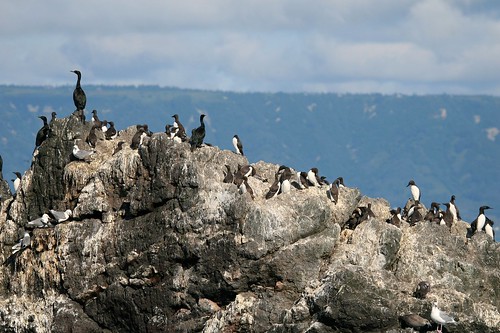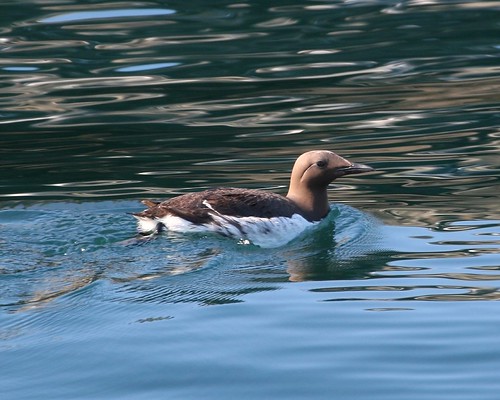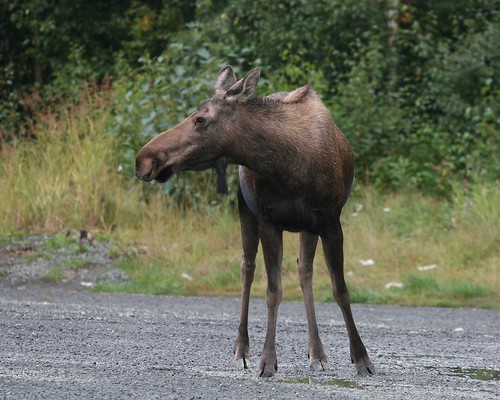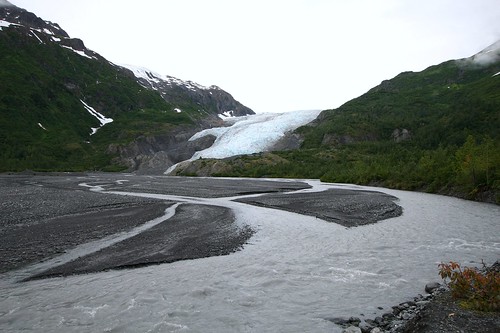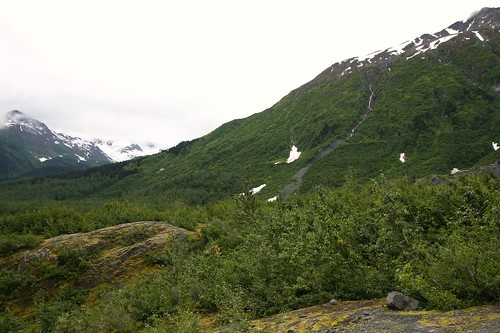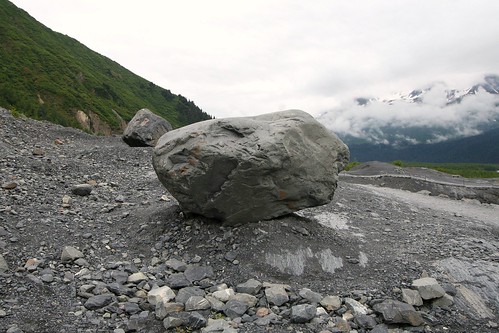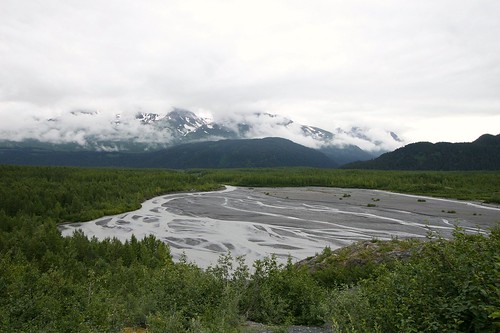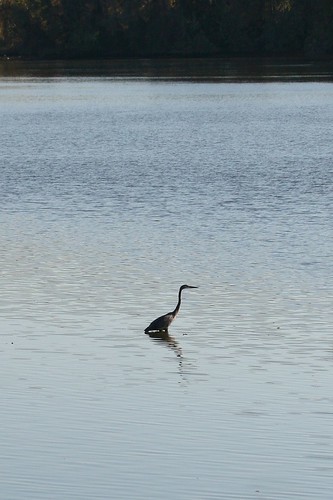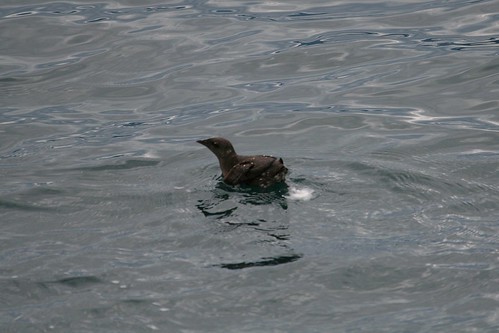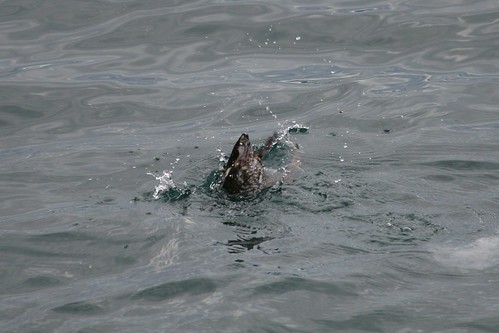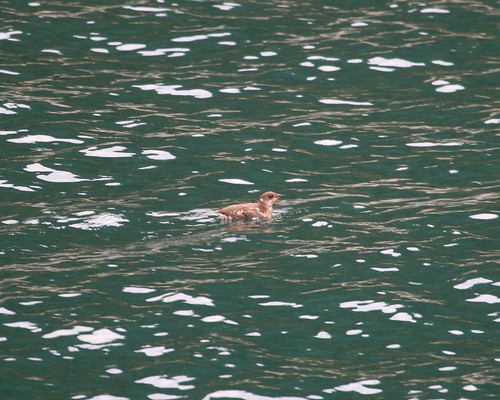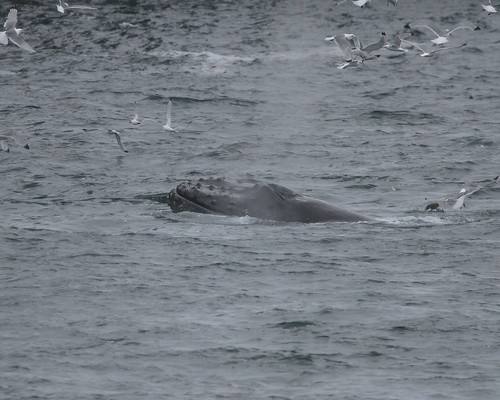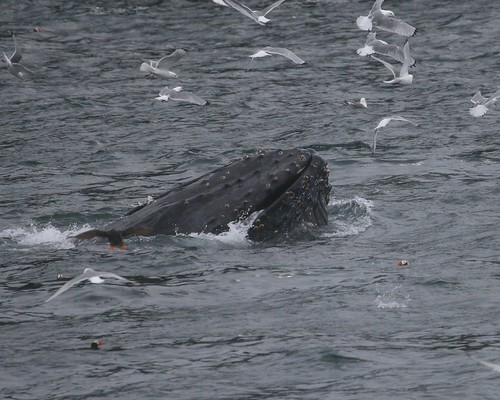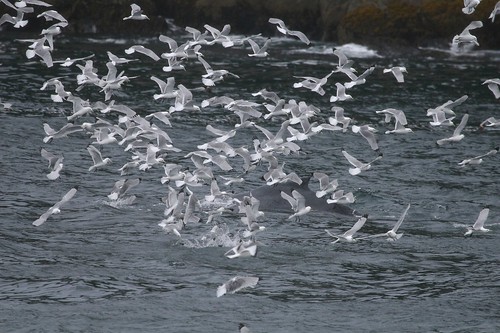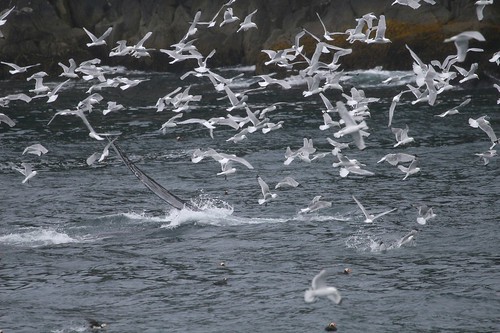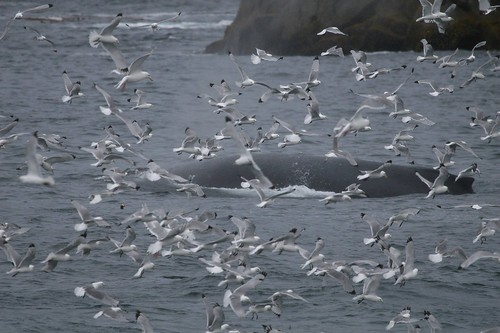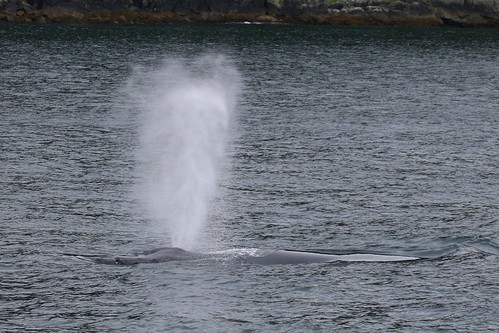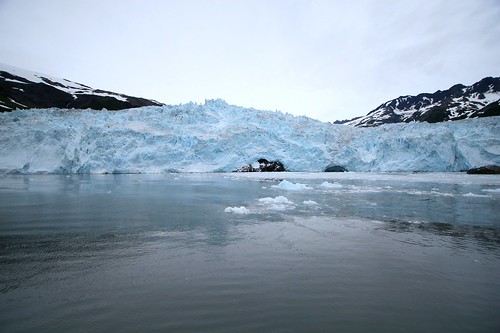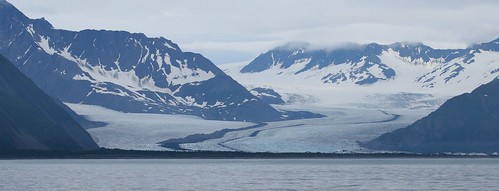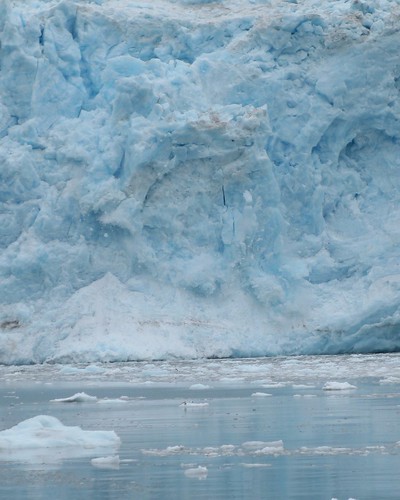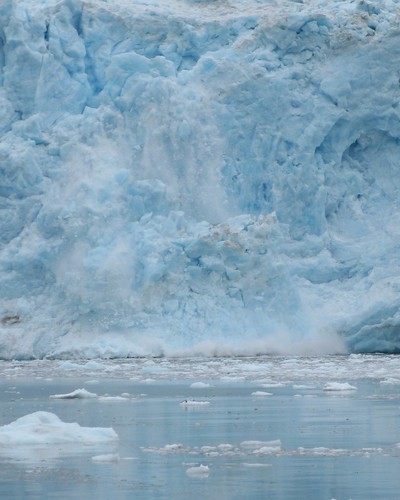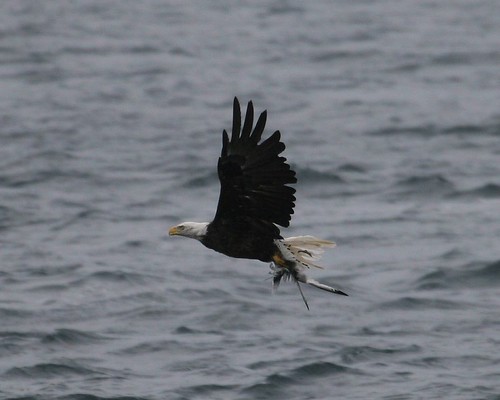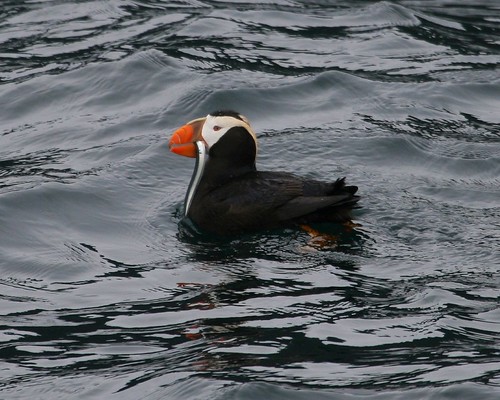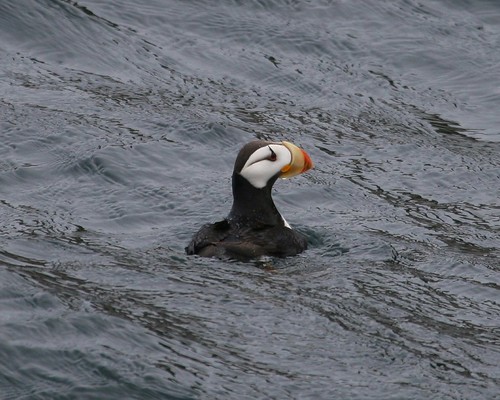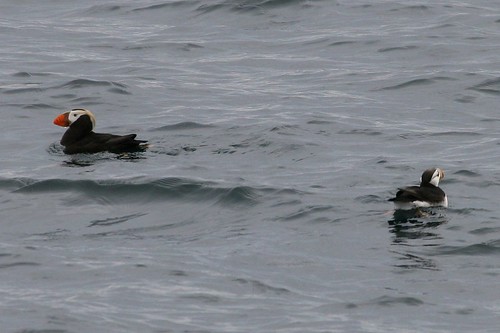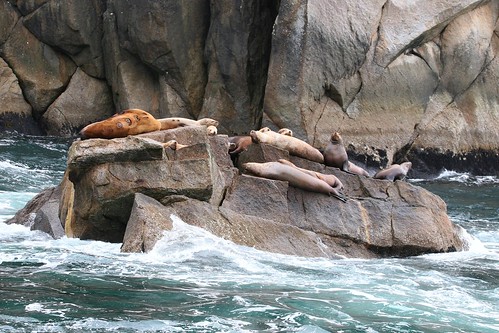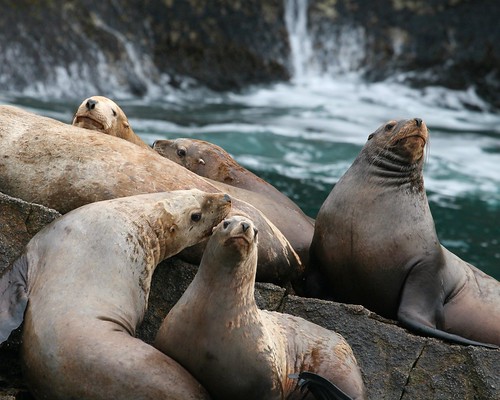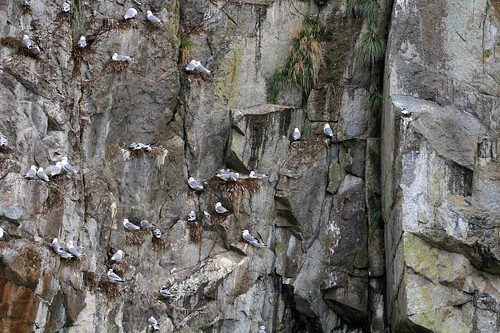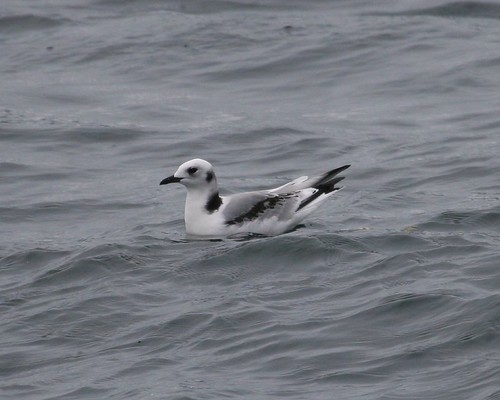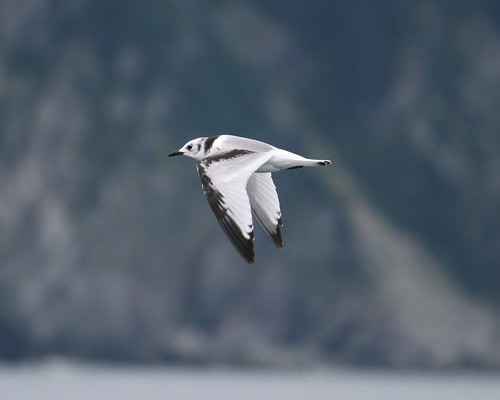As we took our boat ride to Seldovia and back, we both enjoyed the scenery and the out-of-nowhere sunny blue sky. But we both were already thinking about the next day. The day where we drove back to Anchorage. The next day was the day before flying home. The end of the vacation was close enough to feel...to think about and plan for.
This post is all about the end of the vacation. One more post. One more batch of photos...the loose ends pulled together, so to speak. I suspect it is about time anyway. I have milked the Alaska trip for three months now. Heh...I need to blog about something other than my trip to Alaska. So, these last photos bid a fond farewell to Alaska.
First off is the ubiquitous combination of light post and gull. In this case the gull is Glaucous-winged, and clearly feels that it owns that light post.
Next up is a fine example of lawn art from the quaint town of Seldovia. Yes, this amazing wood carving was in a gazebo on someone's lawn.
While in Seldovia, we sat down for a quick drink at a coffee house. The sun was out and it was a tad warm, so we sat outside enjoying having no other obligation than getting back on the boat in an hour. And while we enjoyed our drink and the sun, this Common Raven joined us. I think he was expecting a handout.
These red berries were on the side of the road heading back to Anchorage. We had pulled over to enjoy the view of a distant snow-capped mountain, and the berries refused to be ignored.
And here is that view. I have since forgotten the name of the mountain, but it kept distracting me from what I should have been paying attention to: the road. So I pulled over to give the mountain one last look.
Black Oystercatcher
The boat trip to Seldovia gave me another life bird: Black Oystercatcher. This was a pleasant surprise. I have seen its cousin American Oystercatcher several times back home, but I never really put two and two together to figure out that I might see a Black Oystercatcher while in Alaska. When the boat captain pointed them out on the way to Seldovia, and then took the time to give us a closer look, I fumbled between binoculars and camera...trying to decide whether to be a birdwatcher or a photographer. Luckily I had enough time to be both. I really love their carrot orange bill, and the yellow eye surrounded by the orange eye-ring.
Sea Otter
During both of our Alaskan boat trips, we saw several Sea Otters. On the trip out of Homer, however, the light was much better and we got much closer to the otters.
First things first. Sea Otters are just plain cute. I watched a television show recently that said the animals we think of as cute are the ones whose face has a passing resemblance to human babies. That theory is mildly interesting (and I can give no examples to give it any credence), but when I look at a Sea Otter I only see a resemblance to Ewoks. And Ewoks annoy me. Sea Otters, on the other hand, have yet to annoy me.
We only saw Sea Otters floating about on their backs. Sometimes they had some food item, but usually they were just floating. Some of them barely even kept an eye on the boat on which we were riding. Maybe the sun was just a bit too bright. Or maybe they were just napping.
First things first. Sea Otters are just plain cute. I watched a television show recently that said the animals we think of as cute are the ones whose face has a passing resemblance to human babies. That theory is mildly interesting (and I can give no examples to give it any credence), but when I look at a Sea Otter I only see a resemblance to Ewoks. And Ewoks annoy me. Sea Otters, on the other hand, have yet to annoy me.
We only saw Sea Otters floating about on their backs. Sometimes they had some food item, but usually they were just floating. Some of them barely even kept an eye on the boat on which we were riding. Maybe the sun was just a bit too bright. Or maybe they were just napping.
Views from the Boat
On the way to Seldovia, the boat captain took us past Elephant Rock. The reason for that name is fairly obvious. Two slightly different perspectives on the same rock, give the impression of an elephant raising its trunk.
On the way back from Seldovia, the view of the mountains on Kenai Peninsula was one I will not forget.
On the way back from Seldovia, the view of the mountains on Kenai Peninsula was one I will not forget.
Common Murre
Why did we go to Homer? No reason, really. We had one entire day to spend there. When we arrived in Homer the night before, we had no idea what we were going to do on that day. We just figured that we would find something to do there. After a bit of research, however, we elected to take advantage of one of the local boating companies for an excursion to the little town of Seldovia (population 286 in the 2000 census), across Kachemak Bay from Homer.
View Larger Map
The boating company took you across to Seldovia via the scenic route, let you wander around town for two or three hours, and then brought you back via the direct route. So we got to take another boat trip! It was much shorter than the one out of Seward, but on the other hand it was actually bright blue sky and sunny. A fantastic day by any standard.
Kachemak Bay was very active with birds. The species I saw the most was Common Murre. They are pretty bland looking birds (Or are they "cool looking"? I need to make up my mind!). Dark on top. White underneath. A dark, medium length, pointy bill. They like to float on the water and dive for their food. They were everywhere.
I saw them singly.
I saw them flying in formation.
I saw large groups of them roosting on rocks.
I saw a parent squawking "Watch out for that boat!" to its chick.
Yes...Common Murre were, in fact, fairly common.
View Larger Map
The boating company took you across to Seldovia via the scenic route, let you wander around town for two or three hours, and then brought you back via the direct route. So we got to take another boat trip! It was much shorter than the one out of Seward, but on the other hand it was actually bright blue sky and sunny. A fantastic day by any standard.
Kachemak Bay was very active with birds. The species I saw the most was Common Murre. They are pretty bland looking birds (Or are they "cool looking"? I need to make up my mind!). Dark on top. White underneath. A dark, medium length, pointy bill. They like to float on the water and dive for their food. They were everywhere.
I saw them singly.
I saw them flying in formation.
I saw large groups of them roosting on rocks.
I saw a parent squawking "Watch out for that boat!" to its chick.
Yes...Common Murre were, in fact, fairly common.
Driving to Homer
When we departed Seward, and said goodbye to Exit Glacier, our destination was Homer. Rather than explain the driving route, I will just include a handy Google map. Homer is near the tip of the Kenai Peninsula.
Along that drive we had a Moose sighting. We came over a hill and there was a large gravel area on the right side of the road. In that gravel area, drinking from a puddle of water, was a Moose. We quickly pulled over, joining a couple other vehicles. We then gawked, pointed and took photos from the safety of our car. The Moose drank, looked back, and seemed a bit nervous about all the attention. After just a minute or two, we left the Moose with its puddle and continued on to Homer.
Homer has a neat geologic feature: the Spit. The Homer Spit is a thin strip of land that juts 4.5 miles out into the water of Kachemak Bay. I didn't believe it at first, but it is naturally occurring, with a couple theories on how it came to be: either built by the interaction of water in Kachemak Bay and Cook Inlet, or a moraine left by some long retreated glacier. There are all sorts of restaurants, shops, fishing and tourism businesses along the spit. There is even a campground, a harbor and, out on the very tip, a hotel (which is where we stayed...the building with the purple roof).
Along that drive we had a Moose sighting. We came over a hill and there was a large gravel area on the right side of the road. In that gravel area, drinking from a puddle of water, was a Moose. We quickly pulled over, joining a couple other vehicles. We then gawked, pointed and took photos from the safety of our car. The Moose drank, looked back, and seemed a bit nervous about all the attention. After just a minute or two, we left the Moose with its puddle and continued on to Homer.
Homer has a neat geologic feature: the Spit. The Homer Spit is a thin strip of land that juts 4.5 miles out into the water of Kachemak Bay. I didn't believe it at first, but it is naturally occurring, with a couple theories on how it came to be: either built by the interaction of water in Kachemak Bay and Cook Inlet, or a moraine left by some long retreated glacier. There are all sorts of restaurants, shops, fishing and tourism businesses along the spit. There is even a campground, a harbor and, out on the very tip, a hotel (which is where we stayed...the building with the purple roof).
Exit Glacier
My habit of blogging about things I experienced several months ago leads to weird "blog time warp" situations. Case in point: my last post was a very recent picture and an abrupt departure from all the glorious Alaskan goodness that I have been sharing for several weeks now. Then, to top if off, Tammy and I took a trip to Asheville, NC this past weekend, which gave me a great excuse for not posting anything at all.
Now that we have returned from our trip (with a few pictures in tow), I am refreshed and ready to boldly resume the blogging bonanza. There are still, I think, some very interesting photos to share from the Alaska adventure, so I am going to push through those before sharing anything from this weekend's trip. And to continue through the Alaska photos means that I need to give a blogger's wave goodbye to Seward - it is time to move on to another location. And the perfect segue for that exit is a post about Exit Glacier, the location that served as the exit for the first recorded crossing of the Harding Ice Field.
As you drive out of Seward (or into Seward...there is only one road), you pass a spur that will lead you to Exit Glacier. This spur is the only road that lies within the Kenai Fjords National Park. As you drive down this spur you pass several odd signs that show nothing but four digit numbers. We later learned that those four digit numbers were years, and they marked where Exit Glacier terminated at various points in the past. I cannot remember what the exact year was on the first sign we passed, but it was somewhere in the late 1800's. Once we learned what the numbers represented, we immediately wondered how they knew where the glacier terminus was that long ago?"
Part of the answer turns out to be forest succession. As Exit Glacier recedes it leaves bare ground. Eventually, that bare ground is covered by plants, and then over time, different plants replace the previous plants. It turns out that the order in which plants cover that bare ground and replace each other is fairly predictable. By looking at what is growing at various distances from the current terminus of Exit Glacier, and how old those things are, you can estimate how many years it has been since the terminus was at that point. If my slim explanation of forest succession leaves you wanting more, you can read better explanations of forest succession here and here (PDF).
This next picture was my attempt at capturing evidence of forest succession. On the opposite ridge, you can see "lines" in the vegetation that draw a crude outline of where the edges of Exit Glacier were at some point in the past. As you follow the opposite ridge from right to left, near the left edge of the photo the height of the vegetation suddenly increases, giving a clue to where Exit Glacier previously terminated. Also, as you go up the opposite ridge the type of vegetation changes, giving a clue to the height of Exit Glacier at some point in the past. If you are not sure what I am referring to, then click the picture (or here) and it will take you to my Flickr page for this photo where I used the "note" feature of Flickr to point out these "lines".
At the end of the spur road, there is a visitor center and a couple trail heads (the National Park Service provides an interesting birds eye view map (PDF) using an aerial photograph). One trail leads you to the top of the ridge where Exit Glacier slowly oozes out of the Harding Ice Field. That sounded immensely interesting, but we did not have the time to invest for that hike. Instead we chose the very easy and quick trail to the terminus of Exit Glacier. Although they do not allow you to walk up and touch the glacier (too much risk of a chunk of ice breaking off and landing on you), you can get close enough to feel the cold of the ice.
Here are two more photos, these with the glacier at my back. The first shows a nice sized chunk of rock that was left by the glacier. The second shows the outwash plain (or sandur) of the glacier.
Now that we have returned from our trip (with a few pictures in tow), I am refreshed and ready to boldly resume the blogging bonanza. There are still, I think, some very interesting photos to share from the Alaska adventure, so I am going to push through those before sharing anything from this weekend's trip. And to continue through the Alaska photos means that I need to give a blogger's wave goodbye to Seward - it is time to move on to another location. And the perfect segue for that exit is a post about Exit Glacier, the location that served as the exit for the first recorded crossing of the Harding Ice Field.
As you drive out of Seward (or into Seward...there is only one road), you pass a spur that will lead you to Exit Glacier. This spur is the only road that lies within the Kenai Fjords National Park. As you drive down this spur you pass several odd signs that show nothing but four digit numbers. We later learned that those four digit numbers were years, and they marked where Exit Glacier terminated at various points in the past. I cannot remember what the exact year was on the first sign we passed, but it was somewhere in the late 1800's. Once we learned what the numbers represented, we immediately wondered how they knew where the glacier terminus was that long ago?"
Part of the answer turns out to be forest succession. As Exit Glacier recedes it leaves bare ground. Eventually, that bare ground is covered by plants, and then over time, different plants replace the previous plants. It turns out that the order in which plants cover that bare ground and replace each other is fairly predictable. By looking at what is growing at various distances from the current terminus of Exit Glacier, and how old those things are, you can estimate how many years it has been since the terminus was at that point. If my slim explanation of forest succession leaves you wanting more, you can read better explanations of forest succession here and here (PDF).
This next picture was my attempt at capturing evidence of forest succession. On the opposite ridge, you can see "lines" in the vegetation that draw a crude outline of where the edges of Exit Glacier were at some point in the past. As you follow the opposite ridge from right to left, near the left edge of the photo the height of the vegetation suddenly increases, giving a clue to where Exit Glacier previously terminated. Also, as you go up the opposite ridge the type of vegetation changes, giving a clue to the height of Exit Glacier at some point in the past. If you are not sure what I am referring to, then click the picture (or here) and it will take you to my Flickr page for this photo where I used the "note" feature of Flickr to point out these "lines".
At the end of the spur road, there is a visitor center and a couple trail heads (the National Park Service provides an interesting birds eye view map (PDF) using an aerial photograph). One trail leads you to the top of the ridge where Exit Glacier slowly oozes out of the Harding Ice Field. That sounded immensely interesting, but we did not have the time to invest for that hike. Instead we chose the very easy and quick trail to the terminus of Exit Glacier. Although they do not allow you to walk up and touch the glacier (too much risk of a chunk of ice breaking off and landing on you), you can get close enough to feel the cold of the ice.
Here are two more photos, these with the glacier at my back. The first shows a nice sized chunk of rock that was left by the glacier. The second shows the outwash plain (or sandur) of the glacier.
Time Out
I am taking a break from the Alaska photos this week to share a picture or two that I took this past weekend at Dutch Gap Conservation Area (DGCA). Nothing fancy, but it will take a little less time on my part during a week that has a lot less time available for blogging.
DGCA built a bridge this past winter that turned an eight mile out and back into a five mile loop. The weather was really nice this past Saturday, so Tammy and I went out and hiked the new loop. Along the way we found this Great Blue Heron posing ever so nicely next to the far shore.
DGCA built a bridge this past winter that turned an eight mile out and back into a five mile loop. The weather was really nice this past Saturday, so Tammy and I went out and hiked the new loop. Along the way we found this Great Blue Heron posing ever so nicely next to the far shore.
Marbled Murrelet
While the boat cruised through the waters south of Seward, I saw Murrelets on several occasions. I tried to take photos of most of them, figuring that I could identify them later when I reviewed what my camera captured. But Murrelets are like little toys bobbing and diving in a giant bathtub. They are small birds. And on this day usually far away. When they were not so far, they would quickly dive under the waves as the boat approached. Despite my photos, most of the Murrelets went unidentified. I assume that they were Marbled Murrelets, but I really do not know.
The trio of photos below are three of the better photos that I managed to get. Of course, "better" does not mean "good". The focus on these is very soft. I can tell that the subjects really are Marbled Murrelets, so I guess the photos are not too soft, but I still wish I could have gotten better captures.
The trio of photos below are three of the better photos that I managed to get. Of course, "better" does not mean "good". The focus on these is very soft. I can tell that the subjects really are Marbled Murrelets, so I guess the photos are not too soft, but I still wish I could have gotten better captures.
Humpback Whale
On the way back from Aialik Glacier, the boat cruised by several more of those rocky islands that the birds enjoy so much. As we approached one hunk of rock, the captain noticed something that piqued his interest. All I saw, however, was a rather large flock of birds just above the surface of the water.
I didn't have to wait very long to understand. A Humpback Whale surfaced right where all those birds were flocking.
The birds and the whale were after the same thing: fish. The whale was fishing from below, and the birds from above.
I wonder if any birds, in an ill-timed attempt at a fish, have ever been eaten by a whale. I don't see how the whale could avoid any bird that got in the way. And there were enough Kittiwakes, Gulls and Puffins taking their chances for a fish that it just seems inevitable that one of those birds would eventually end up as a bit of whale chow. If one did, I am not sure how I would even notice.
Eventually the whale moved in one direction, and our boat moved in another. The birds seemed to settle down as well. I think that meant that there were no more fish to be had. We got a few more glimpses of the whale surfacing, spray puffing up into the air, before we headed on our way.
I didn't have to wait very long to understand. A Humpback Whale surfaced right where all those birds were flocking.
The birds and the whale were after the same thing: fish. The whale was fishing from below, and the birds from above.
I wonder if any birds, in an ill-timed attempt at a fish, have ever been eaten by a whale. I don't see how the whale could avoid any bird that got in the way. And there were enough Kittiwakes, Gulls and Puffins taking their chances for a fish that it just seems inevitable that one of those birds would eventually end up as a bit of whale chow. If one did, I am not sure how I would even notice.
Eventually the whale moved in one direction, and our boat moved in another. The birds seemed to settle down as well. I think that meant that there were no more fish to be had. We got a few more glimpses of the whale surfacing, spray puffing up into the air, before we headed on our way.
Aialik Glacier
The boat trip we took from Seward was ultimately headed towards Aialik Glacier. This is a tidewater glacier. It terminates into the waters of Aialik Bay, and the tour boat could get fairly close to it.
Contrast that with Bear Glacier which had receded from the shoreline and there is now a lake and a thin strip of land between the glacier and Resurrection Bay. This is a distant photo of Bear Glacier as we cruised by. You can see its racing stripes (the dark line up the middle...called medial moraines). This occurs when two glaciers merge and their lateral moraines have gone from being on the outside of each individual glacier, to instead being on the inside of the combined glacier. If you look closely at the photo, you can see that there are two racing stripes at the very bottom of the glacier, and only one further up. The second racing stripe comes from a third glacier merging into the larger glacier (coming in from the left near the bottom).
When we got to Aialik Glacier, the captain cut the engines off and we just floated. Similar to when we stopped to watch the Orca, the silence was punctuated by the occasional sounds of Mother Nature. This time, instead of the sounds of whales breaching, the sounds were the very loud pops and groans of the glacier as it inched its way towards the sea. Every now and then you would see bits of the glacier crumble away into the water. Usually it was small debris that chattered as it rolled down the face, but every now and then it was a larger piece that calved off with a dramatic roar.
Contrast that with Bear Glacier which had receded from the shoreline and there is now a lake and a thin strip of land between the glacier and Resurrection Bay. This is a distant photo of Bear Glacier as we cruised by. You can see its racing stripes (the dark line up the middle...called medial moraines). This occurs when two glaciers merge and their lateral moraines have gone from being on the outside of each individual glacier, to instead being on the inside of the combined glacier. If you look closely at the photo, you can see that there are two racing stripes at the very bottom of the glacier, and only one further up. The second racing stripe comes from a third glacier merging into the larger glacier (coming in from the left near the bottom).
When we got to Aialik Glacier, the captain cut the engines off and we just floated. Similar to when we stopped to watch the Orca, the silence was punctuated by the occasional sounds of Mother Nature. This time, instead of the sounds of whales breaching, the sounds were the very loud pops and groans of the glacier as it inched its way towards the sea. Every now and then you would see bits of the glacier crumble away into the water. Usually it was small debris that chattered as it rolled down the face, but every now and then it was a larger piece that calved off with a dramatic roar.
Bald Eagle Clutching Kittiwake
At one point on the Seward boat trip I noticed a Bald Eagle flying by. I whipped the camera into position and snapped a bunch of photos, barely realizing that the Eagle had something clutched in its talons. Later on that night (or maybe even the next week), as I reviewed the photos I had taken, I realized that the "something" in the Eagle's talons was a bird. Or what was left of a bird. Hard to say.
After some staring, and head scratching, I came to the highly speculative conclusion that the victim used to be a juvenile Black-legged Kittiwake. There were certainly enough of those around for the Eagle to choose from. Unfortunately, I did not see how this particular Kittiwake came to be in the possession of the Eagle, so we will all have to use our imagination.
After some staring, and head scratching, I came to the highly speculative conclusion that the victim used to be a juvenile Black-legged Kittiwake. There were certainly enough of those around for the Eagle to choose from. Unfortunately, I did not see how this particular Kittiwake came to be in the possession of the Eagle, so we will all have to use our imagination.
Puffins
I am lucky. I had the opportunity in 2006 to see Atlantic Puffins. That was a tremendously cool experience, and something I am not likely to forget. This blog existed back then, so you can check out what I had to say about those Atlantic Puffins. Don't get your hopes up for a story of interest, a pile of information or a dose of opinion. My writing style in this blog has evolved just a "tad" between 2006 and now. I look back and chuckle. That Atlantic Puffin post was so...sparse.
Now fast forward to our boat trip out of Seward. How do I compare my Atlantic Puffin experience to this one? Well, for starters, the trip out of Seward was a double-puffin-experience (DPE). That's right! There were two species of puffin to be seen in the waters south of Seward. How cool is that?
First up is the Tufted Puffin. Sure enough, they look like a puffin. That massive bill is pretty unmistakable. But this species has those interesting pale yellow plumes that drape back over their head like highly coiffed bits of hair. The first photo shows one with a single fish hanging out of his bill. They can carry nearly twenty small fish in their bill, all lined up side by side. The second photo catches a Tufted Puffin just about to take flight. He also has a fish, but it is hanging out of the opposite side of his bill.
And then there is the Horned Puffin. No, he does not have real horns. Their "horn" is the dark line that juts up above their eye. Their breast and belly are white, and their bill has a broad yellow section near the base.
Here is a final photo that has a Tufted Puffin and a Horned Puffin in the same frame. The Horned Puffin kept turning his back on me, but you can still make some comparisons between the two.
Now fast forward to our boat trip out of Seward. How do I compare my Atlantic Puffin experience to this one? Well, for starters, the trip out of Seward was a double-puffin-experience (DPE). That's right! There were two species of puffin to be seen in the waters south of Seward. How cool is that?
First up is the Tufted Puffin. Sure enough, they look like a puffin. That massive bill is pretty unmistakable. But this species has those interesting pale yellow plumes that drape back over their head like highly coiffed bits of hair. The first photo shows one with a single fish hanging out of his bill. They can carry nearly twenty small fish in their bill, all lined up side by side. The second photo catches a Tufted Puffin just about to take flight. He also has a fish, but it is hanging out of the opposite side of his bill.
And then there is the Horned Puffin. No, he does not have real horns. Their "horn" is the dark line that juts up above their eye. Their breast and belly are white, and their bill has a broad yellow section near the base.
Here is a final photo that has a Tufted Puffin and a Horned Puffin in the same frame. The Horned Puffin kept turning his back on me, but you can still make some comparisons between the two.
Stellar Sea Lion
This is a group of Stellar Sea Lions lounging on a bit of convenient rock. The boat got fairly close to that rock, but the sea lions did not get spooked to the point of leaving their comfy perch. At worst, they just kept a close eye on us, but several just kept sleeping (meh...just another stoopid boat).
Stellar Sea Lions are undergoing some significant changes. There are two populations of Stellar Sea Lion: eastern (found on the eastern coast of Asia) and western (found on the western coast of North America). For some yet to be agreed upon reason, the western population has declined between 70% and 80% since the 1970's, and has been listed as endangered under the Endangered Species Act since 1990. There are lots of theories to help explain the decline (including decreasing populations of fish from climate change or our economy, increasing predation by Orca, disease, pollution, or some combination of each of these), but there is no consensus on which one(s) are the most likely.
Stellar Sea Lions are undergoing some significant changes. There are two populations of Stellar Sea Lion: eastern (found on the eastern coast of Asia) and western (found on the western coast of North America). For some yet to be agreed upon reason, the western population has declined between 70% and 80% since the 1970's, and has been listed as endangered under the Endangered Species Act since 1990. There are lots of theories to help explain the decline (including decreasing populations of fish from climate change or our economy, increasing predation by Orca, disease, pollution, or some combination of each of these), but there is no consensus on which one(s) are the most likely.
Black-legged Kittiwake
It sure is hard following up that last post with something just as exciting. After a little deliberation, I decided to post some pictures of Black-legged Kittiwake. Yeah...I agree. Kittiwakes are not nearly as exciting as an Orca breaching the surface in pursuit of a meal (if you didn't see that post, you should check it out).
Kittiwake. Such a fancy name for what is otherwise just another gull. I had to research it as I wrote this post, but it turns out that their name comes from the call they make. This one is the Black-legged variety (instead of the Red-legged variety), and it was a life bird for me. When we headed to Alaska, I was pretty sure I would end up seeing a Black-legged Kittiwake without really trying. I was right.
On our boat trip out of Seward, almost every gull we saw was a Black-legged Kittiwake. The boat trip took us past a few nesting locations. These were essentially small rock islands. If you imagine steep mountains that were, except for the very tip, submerged by water, then you can imagine the appearance of these islands. Only the birds found any use out of them, using any tiny bit of horizontal surface as a place to roost or nest.
The adults were fairly plain looking. White underneath, gray on top, a yellow bill with no black or red marks on it, and, of course, black legs. The tips of the wings were black with no white.
The first year birds, to me, had a much more interesting appearance. Their bills were black instead of yellow, and there were several spots and lines of black mixed in with the gray and white coloration.
Kittiwake. Such a fancy name for what is otherwise just another gull. I had to research it as I wrote this post, but it turns out that their name comes from the call they make. This one is the Black-legged variety (instead of the Red-legged variety), and it was a life bird for me. When we headed to Alaska, I was pretty sure I would end up seeing a Black-legged Kittiwake without really trying. I was right.
On our boat trip out of Seward, almost every gull we saw was a Black-legged Kittiwake. The boat trip took us past a few nesting locations. These were essentially small rock islands. If you imagine steep mountains that were, except for the very tip, submerged by water, then you can imagine the appearance of these islands. Only the birds found any use out of them, using any tiny bit of horizontal surface as a place to roost or nest.
The adults were fairly plain looking. White underneath, gray on top, a yellow bill with no black or red marks on it, and, of course, black legs. The tips of the wings were black with no white.
The first year birds, to me, had a much more interesting appearance. Their bills were black instead of yellow, and there were several spots and lines of black mixed in with the gray and white coloration.
Subscribe to:
Posts (Atom)
